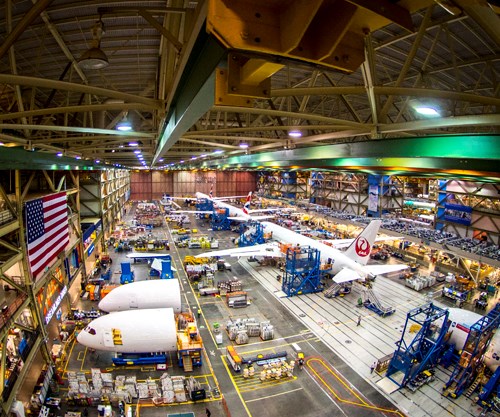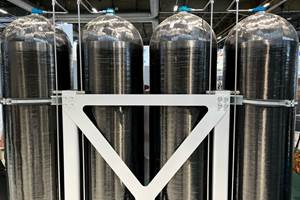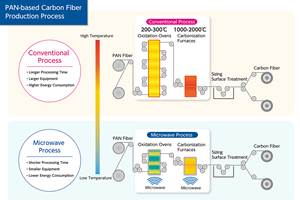An aerocomposites wish list
Boeing R&T fellow Tom Tsotsis offers his vision of how design and manufacture of composite parts and structures might evolve in the aerospace industry.

Dr. Thomas Tsotsis, technical fellow, materials and process technology at Boeing Research & Technology (Huntington Beach, CA, US), was a keynote speaker at the Society of Plastics Engineers’ (SPE) ANTEC conference in Anaheim, CA, on May 10. Tsotsis’ presentation title was simple: “A path for composites.” It might also have been titled, “My composites wish list.”
Admittedly, the complete composites manufacturing strategy of a company as big as Boeing cannot be ascribed to one person at Boeing, but Tsotsis’ long experience with aerocomposites does give his words weight, and what he had to say was interesting.
First, he reviewed the history of prepreg use, noting that it became the preferred material form because it enabled manufacturers to achieve consistent resin matrix ratios in finished products. Prepregs have also been well qualified and are well supported with material characterization data. He also noted that prepregs are difficult to form in to complex shapes, have a limited working life, must be kept frozen when not in use, and require expensive “monument” equipment — ATLs and autoclaves — that tend to become workflow bottlenecks.
Liquid molding, on the other hand, he said, offers fabricators the ability to use 3D preforms, braids and weaves; allows more material flexibility to meet a variety of end-use requirements; eliminates the use of an autoclave; and requires no freezer. Downsides? Fiber/resin ratios are more difficult to control with liquid molding, composites made via liquid molding are not as well qualified, and liquid molding processes require additional quality control steps that prepregs don’t require. Further, he admitted that companies like Boeing have invested millions of dollars in autoclaves, thus their use is, in many ways, imperative.
In short, said Tsotsis, he said he believes the aerospace industry needs to “get out of the prepreg box” and look more seriously at new chemistries, collaborate to develop reliable design models, increase automation, reduce assembly costs, more proactively address environmental concerns, and more effectively leverage knowledge from other composites end markets.
From the design side, Tsotsis said he would like to see more innovation in chemistry so that resins can be tailored to designs, rather than designs tailored to chemistries, which he believes is the current modus operandi. In addition, he said he would like to see molecular dynamics tools better developed and definitively linked to verifiable test data. And model develpment on the whole, he said, is too siloed and needs to be addressed more cooperatively and collaboratively with suppliers, OEMs and researchers. Finally, he said, “modeling of strength needs a quantum improvement to be truly useful.”
On the aerocomposites manufacturing floor, Tsotsis said, quality control drives everything, and because of that, process control is paramount. But, unlike the automotive industry, where quality is measured by process consistency, aerospace relies on 100% inspection of finished parts, regardless of process quality. The difference, of course, are the risks involved, and in aerospace there is no room for error.
Tsotsis ended his presentation with a reminder of the value of change, and a desire for a willingness to see technical maturation continue: “Just because we’ve done something that way does not mean it’s the best way.”
Related Content
Hexagon Purus Westminster: Experience, growth, new developments in hydrogen storage
Hexagon Purus scales production of Type 4 composite tanks, discusses growth, recyclability, sensors and carbon fiber supply and sustainability.
Read MoreASCEND program update: Designing next-gen, high-rate auto and aerospace composites
GKN Aerospace, McLaren Automotive and U.K.-based partners share goals and progress aiming at high-rate, Industry 4.0-enabled, sustainable materials and processes.
Read MoreRecycling hydrogen tanks to produce automotive structural components
Voith Composites and partners develop recycling solutions for hydrogen storage tanks and manufacturing methods to produce automotive parts from the recycled materials.
Read MoreMicrowave heating for more sustainable carbon fiber
Skeptics say it won’t work — Osaka-based Microwave Chemical Co. says it already has — and continues to advance its simulation-based technology to slash energy use and emissions in manufacturing.
Read MoreRead Next
Plant tour: Daher Shap’in TechCenter and composites production plant, Saint-Aignan-de-Grandlieu, France
Co-located R&D and production advance OOA thermosets, thermoplastics, welding, recycling and digital technologies for faster processing and certification of lighter, more sustainable composites.
Read MoreDeveloping bonded composite repair for ships, offshore units
Bureau Veritas and industry partners issue guidelines and pave the way for certification via StrengthBond Offshore project.
Read MoreAll-recycled, needle-punched nonwoven CFRP slashes carbon footprint of Formula 2 seat
Dallara and Tenowo collaborate to produce a race-ready Formula 2 seat using recycled carbon fiber, reducing CO2 emissions by 97.5% compared to virgin materials.
Read More






















